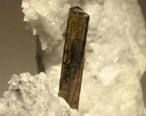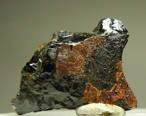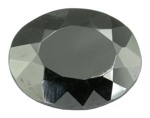Allanit-(Ce)
Alanitas, Allaniet, Alanāts, Allaniit, Allanite, Optit, Ортит, אלניט, แอลลาไนต์, 앨러 나이트, 褐れん石, 褐帘石
Allgemein bekannt
seltener (sogenannte Sammlersteine)
ganz selten (Raritäten)
relativ seltenes organisches Material
|
Chemische Formel:
(Ca,Ce)2(Al,Fe2+,Fe3+)3(SiO4((Si2O7O(OH)
Mineralklasse: Silikate Kristallsystem: monoklin Mohs-Härte: 5,5 - 6 Dichte (g/cm3): 3,5 - 4,2 Refraktions-Index: 1,640 - 1,828 Spaltbarkeit: schlecht Farben: farblos, rosa, braun, schwarz Transparenz: transparent - opak Glanz: Glasglanz - Harzglanz - submetallisch Fluoreszenz: - Pleochroismus: X: olivgrün, rotbraun; Y: braun, gelbbraun; Z: rotbraun, grünbraun Größter Kristall: 90 cm? Fundorte: weltweit Entdeckung: 1810 Erstbeschreibung: 1810 (Thomson) Name: zu Ehren des schottischen Mineralogen Thomas Allan (1777 - 1833) |
|
Allanit-(Ce) Mineral
Größe: 5,5 x 4,5 x 1,5 cm Herkunft: Trimouns Talk Mine / Luzenac / Ariège / Midi-Pyrénées / Frankreich Foto mit freundlicher Erlaubnis von © www.irocks.com |
 |
|
Allanit-(Ce) Mineral
Größe: 2,7 x 1,8 x 0,9 cm Herkunft: Minas Gerais / Brasilien Foto mit freundlicher Erlaubnis von © www.lucianabarbosa.com |
 |
|
Allanit-(Ce) Mineral
Bildbreite: 0,6 cm Herkunft: Laacher See / Eifel / Deutschland Foto mit freundlicher Erlaubnis von © Stephan Wolfsried |
 |
|
Allanit-(Ce)
Größe: 1,22 x 0,96 x 0,64 cm Gewicht: 6,22 ct Herkunft: Brasilien Foto mit freundlicher Erlaubnis von © www.gemfrance.com |
 |
⇐ Intro Seite ⇐ Edelsteine